Damage Analysis of Composite CFRP Tubes Using Acoustic Emission Monitoring and Pattern Recognition Approach
Abstract
1. Introduction
2. Experimental Procedure
2.1. Test Sample Characterization
2.2. Three-Point Bending Test
2.3. Acoustic Emission Monitoring
3. Results and Discussion
3.1. Mechanical Properties and Basic AE Signal Analysis
3.2. AE Signal Analysis Using Pattern Recognition Approach
4. Concluding Remarks
- Four damage mechanisms have been identified using the above-mentioned techniques, namely the fiber break, delamination, debonding, and matrix cracking. The application of the boundary curve appeared to be an effective tool for the further refinement of the results across the individual clusters.
- The fiber break failure mechanism has been identified across all clusters resulting in the wide amplitude as well as energy span. This finding has been supported by various research projects/studies/papers.
- It was found that the matrix cracking failure mechanism generates AE signals with the frequency band between 50 and 200 kHz. The result is in accordance with most studies; however, even in this matter a certain contradiction can be found [30].
- The distinction between delamination/debonding failure mode seems to be a relatively challenging, since both failure mechanisms report very similar frequency spectra [21]. However, according to the presented study, we can find the difference in the energy as well as amplitude values of both mechanisms.
Author Contributions
Funding
Institutional Review Board Statement
Informed Consent Statement
Data Availability Statement
Conflicts of Interest
References
- Unnthorsson, R.; Runarsson, T.P.; Jonsson, M.T. Acoustic emission based fatigue failure criterion for CFRP. Int. J. Fatigue 2008, 30, 11–20. [Google Scholar] [CrossRef]
- Majko, J.; Handrik, M.; Vaško, M.; Sága, M. Influence of Fiber Deposition and Orientation on Stress Distribution in Specimens Produced Using 3D Printing. J. Mech. Eng. 2019, 69, 81–88. [Google Scholar]
- Dorčiak, F.; Vaško, M.; Handrik, M.; Bárnik, F.; Majko, J. Tensile test for specimen with different size and shape of inner structures created by 3D printing. Transp. Res. Procedia 2019, 40, 671–677. [Google Scholar] [CrossRef]
- Majko, J.; Sága, M.; Vaško, M.; Handrik, M.; Barnik, F.; Dorčiak, F. FEM analysis of long-fibre composite structures created by 3D printing. Transp. Res. Procedia 2019, 40, 792–799. [Google Scholar] [CrossRef]
- Awad, Z.K.; Aravinthan, T.; Zhuge, Y.; Gonzalez, F. A review of optimization techniques used in the design of fibre composite structures for civil engineering applications. Mater. Des. 2012, 33, 534–544. [Google Scholar] [CrossRef]
- Xu, J.; Wang, W.; Han, Q.; Liu, X. Damage pattern recognition and damage evolution analysis of unidirectional CFRP tendons under tensile loading using acoustic emission technology. Comput. Struct. 2020, 238, 1–10. [Google Scholar] [CrossRef]
- Libonati, F.; Vergani, L. Damage assessment of composite materials by means of thermographic analyses. Compos. Part B 2013, 50, 82–90. [Google Scholar] [CrossRef]
- Heuer, H.; Schulze, M.; Pooch, M.; Gäbler, S.; Nocke, A.; Bardl, G. Review on quality assurance along the CFRP value chain—Nondestructive testing of fabrics, preforms and CFRP by HF radio wave techniques. Compos. Part B 2015, 77, 494–501. [Google Scholar] [CrossRef]
- Dong, J.; Kim, B.; Locquet, A.; McKeon, P.; Declercq, N.; Citrin, D.S. Nondestructive evaluation of forced delamination in glass fiber reinforced composites by terahertz and ultrasonic waves. Compos. Part B 2015, 79, 667–675. [Google Scholar] [CrossRef]
- Garcea, S.C.; Wang, Y.; Withers, P.J. X-ray computed tomography of polymer composites. Compos. Sci. Technol. 2018, 156, 305–319. [Google Scholar] [CrossRef]
- Dahmene, F.; Yaacoubi, S.; Mountassir, M.E.L. Acoustic Emission of Composites Structures: Story, Success, and Challenges. Phys. Procedia 2015, 70, 599–603. [Google Scholar] [CrossRef]
- Saeedifar, M.; Fotouhi, M.; Najafabadi, M.A.; Toudeshky, H.H.; Minak, G. Prediction of quasi-static delamination onset and growth in laminatedcomposites by acoustic emission. Compos. Part B 2016, 85, 113–122. [Google Scholar] [CrossRef]
- Crivelli, D.; Guagliano, M.; Eaton, M.; Pearson, M.; Al-Jumaili, S.; Holford, K.; Pullin, R. Localization and identification of fatigue matrix cracking and delamination in a carbon fibre panel by acoustic emission. Compos. Part B 2015, 74, 1–12. [Google Scholar] [CrossRef]
- Kocich, R.; Cagala, M.; Crha, J.; Kozelsky, P. Character of acoustic emission signal generated during plastic deformation. In Proceedings of the 30th European Conference on Acoustic Emission Testing & 7th International Conference on Acoustic Emission, University of Granada, Granada, Spain, 12–15 September 2012. [Google Scholar]
- Tang, J.; Soua, S.; Mares, C.; Gan, T.-H. Pattern Recognition Approach to acoustic emission data originating from fatigue of wind turbine blades. Sensors 2017, 17, 2507. [Google Scholar] [CrossRef]
- Assi, L.; Soltangharaei, V.; Anay, R.; Ziehl, P.; Matta, F. Unsupervised and supervised pattern recognition of acoustic emission signals during early hydration of Portland cement paste. Cem. Concr. Res. 2018, 103, 216–225. [Google Scholar] [CrossRef]
- Doan, D.D.; Ramasso, E.; Placet, V.; Zhang, S.; Boubakar, L.; Zerhouni, N. An unsupervised pattern recognition approach for AE data originating from fatigue tests on polymer–composite materials. Mech. Syst. Signal Process. 2015, 64, 465–478. [Google Scholar] [CrossRef]
- Chen, B.; Wang, Y.; Zhaoli, Y. Use of Acoustic Emission and Pattern Recognition for Crack Detection of a Large Carbide Anvil. Sensors 2018, 18, 386. [Google Scholar] [CrossRef]
- Anastasopoulos, A. Pattern recognition techniques for acoustic emission based condition assessment of unfired pressure vessels. J. Acoust. Emiss. 2005, 23, 318–330. [Google Scholar]
- Baran, I.; Nowak, M.; Ono, K. Acoustic emission pattern recognition analysis applied to the over-strained pipes in a polyethylene reactor. J. Acoust. Emiss. 2006, 24, 44–51. [Google Scholar]
- Chou, H.-Y. Damage Analysis of Composite Pressure Vessels Using Acoustic Emission Monitoring. Ph.D. Thesis, School of Aerospace, Mechanical & Manufacturing Engineering College of Science Engineering and Health, RMIT University, Melbourne, Australia, 2011. [Google Scholar]
- Ono, K.; Kawamoto, K. Digital signal analysis of acoustic emission from carbon fiber/epoxy composites. J. Acoust. Emiss. 1990, 9, 109–116. [Google Scholar]
- Ono, K. Acoustic emission behavior of flawed unidirectional carbon fiber-epoxy composites. J. Reinf. Plast. Compos. 1988, 7, 90–105. [Google Scholar] [CrossRef]
- Bohse, J. Acoustic emission characteristics of micro-failure processes in polymer blends and composites. Compos. Sci. Technol. 2000, 60, 1213–1226. [Google Scholar] [CrossRef]
- Komai, K.; Minoshima, K.; Shibutani, T. Investigations of the fracture mechanism of carbon/epoxy composites by AE signal analyses. JSME Int. J. Ser. 1 Solid Mech. Strength Mater. 1991, 34, 381–388. [Google Scholar] [CrossRef]
- Godin, N.; Huguet, S.; Gaertner, R.; Salmon, L. Clustering of acoustic emission signals collected during tensile tests on unidirectional glass/polyester composite using supervised and unsupervised classifiers. NDT&E Int. 2004, 37, 253–264. [Google Scholar]
- Baccar, D.; Söffker, D. Identification and classification of failure modes in laminated composites by using a multivariable statistical analysis of wavelet coefficients. Mech. Syst. Signal Process. 2017, 96, 77–87. [Google Scholar] [CrossRef]
- Prakash, R.V.; Maharana, M. Damage detection using infrared thermographz in a carbon-flax fiber hybrid composite. Procedia Struct. Integr. 2017, 7, 283–290. [Google Scholar] [CrossRef]
- Munoz, V.; Valés, B.; Perrin, M.; Pastor, M.L.; Welemane, H.; Cantarel, A. Damage detection in CFRP by coupling acoustic emission and infrared thermography. Compos. Part B 2016, 85, 68–75. [Google Scholar] [CrossRef]
- Gutkin, R.; Green, C.J.; Vangrattanachai, S.; Pinho, S.T.; Robinson, P.; Curtis, P.T. On acoustic emission for failure investigation in CFRP: Pattern recognition and peak frequency analyses. Mech. Syst. Signal Process. 2011, 25, 1393–1407. [Google Scholar] [CrossRef]
- Sause, M.G.R. Investigation of pencil lead breaks as acoustic emission sources. J. Acoust. Emiss. 2011, 29, 184–196. [Google Scholar]
- Krietsch, T.; Bohse, J. Selection of acoustic emissions and classification of damage mechanisms in fiber composite materials. J. Acoust. Emiss. 1998, 16, 233–242. [Google Scholar]
- Nam, K.-W.; Ahn, S.-H.; Moon, C.-K. Fracture behavior of carbon fiber reinforced plastics determined by the time-frequency analysis method. J. Appl. Polym. Sci. 2003, 88, 1659–1664. [Google Scholar] [CrossRef]
- Siron, O.; Tsuda, H. Acoustic emission in carbon fibre-reinforced plastic materials. Ann. Chim. Sci. Mater. 2000, 25, 533–537. [Google Scholar] [CrossRef]
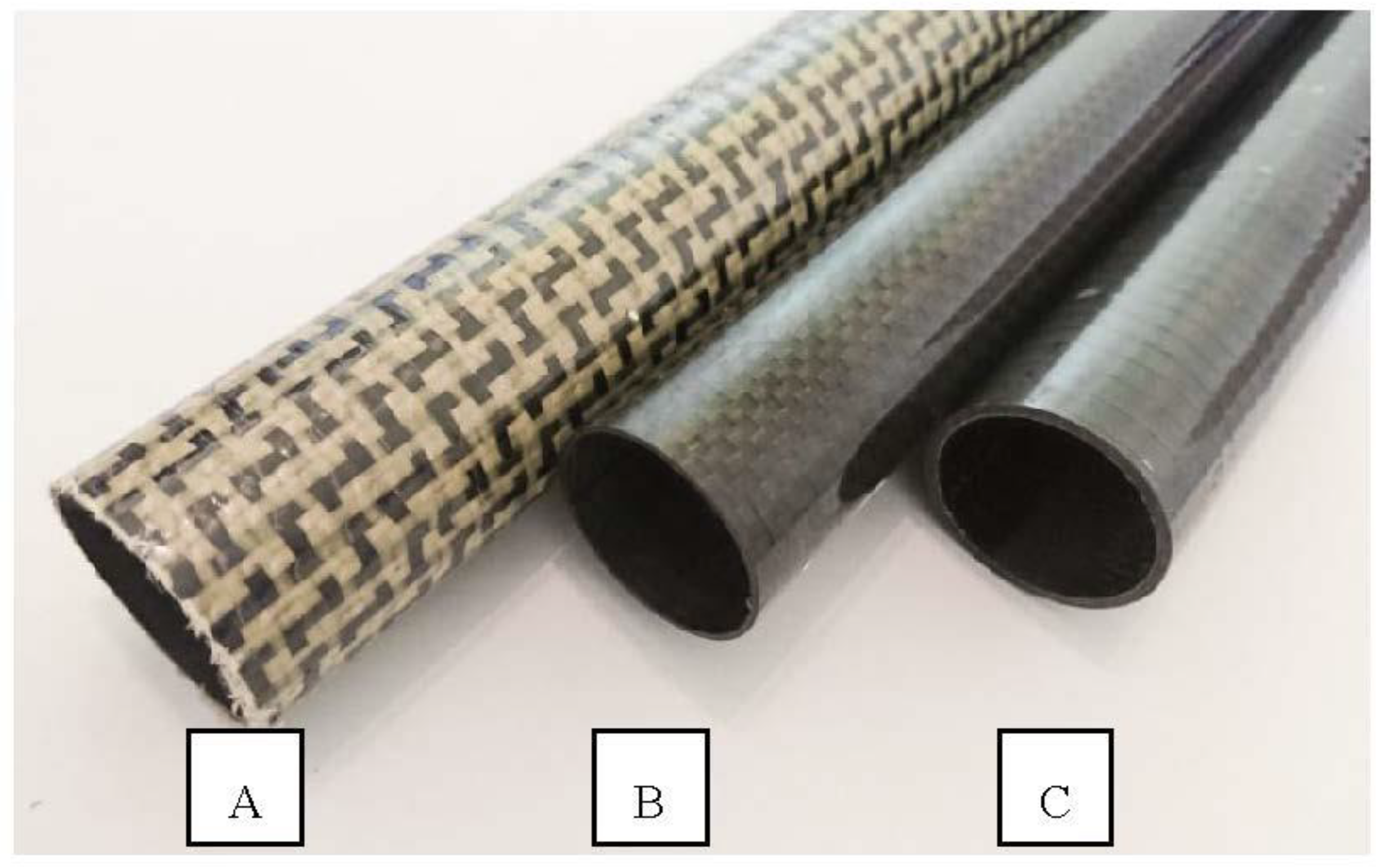
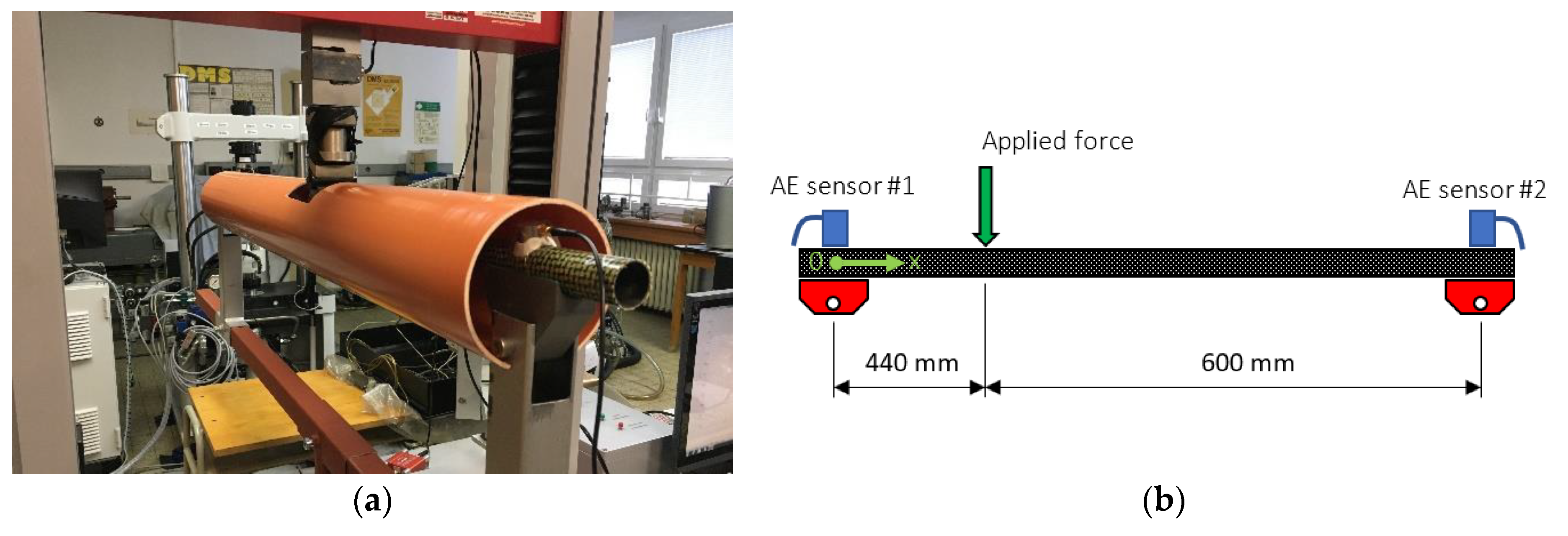
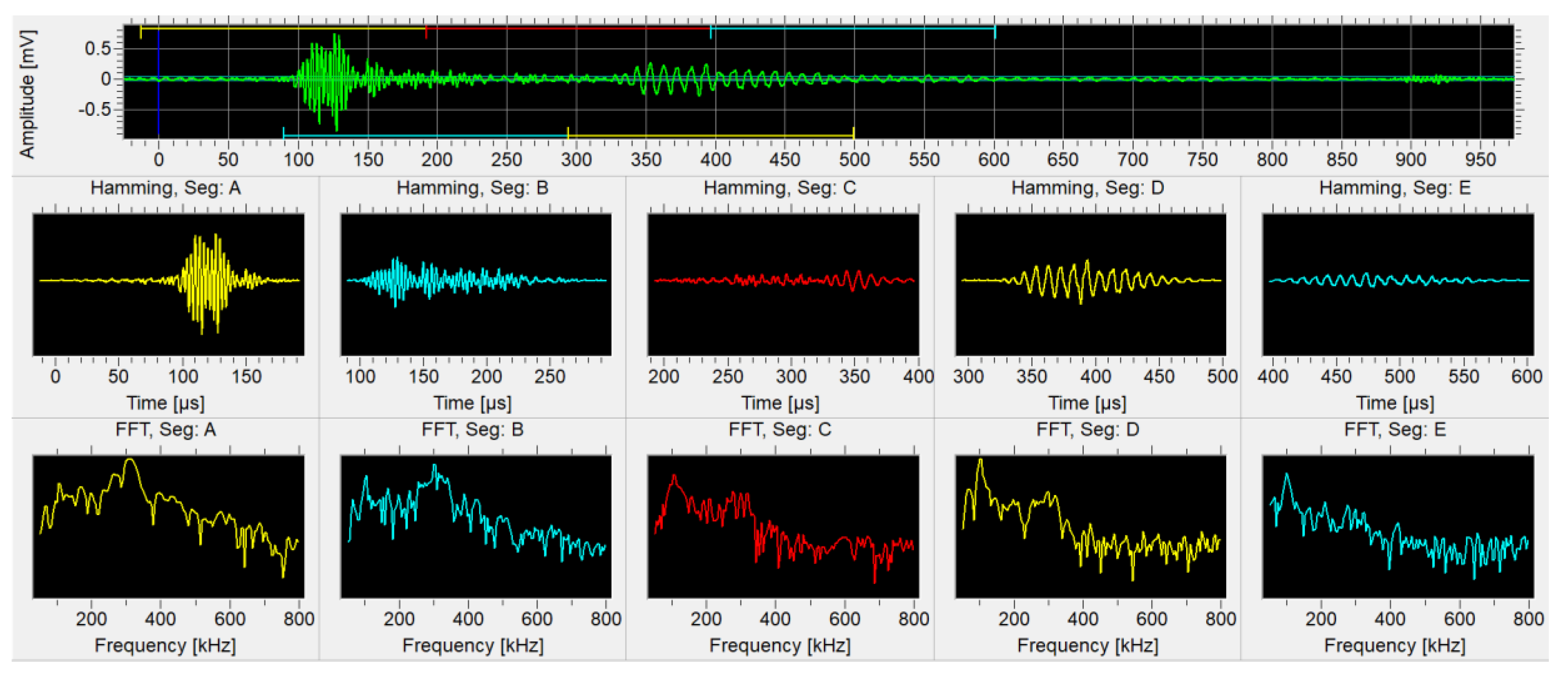

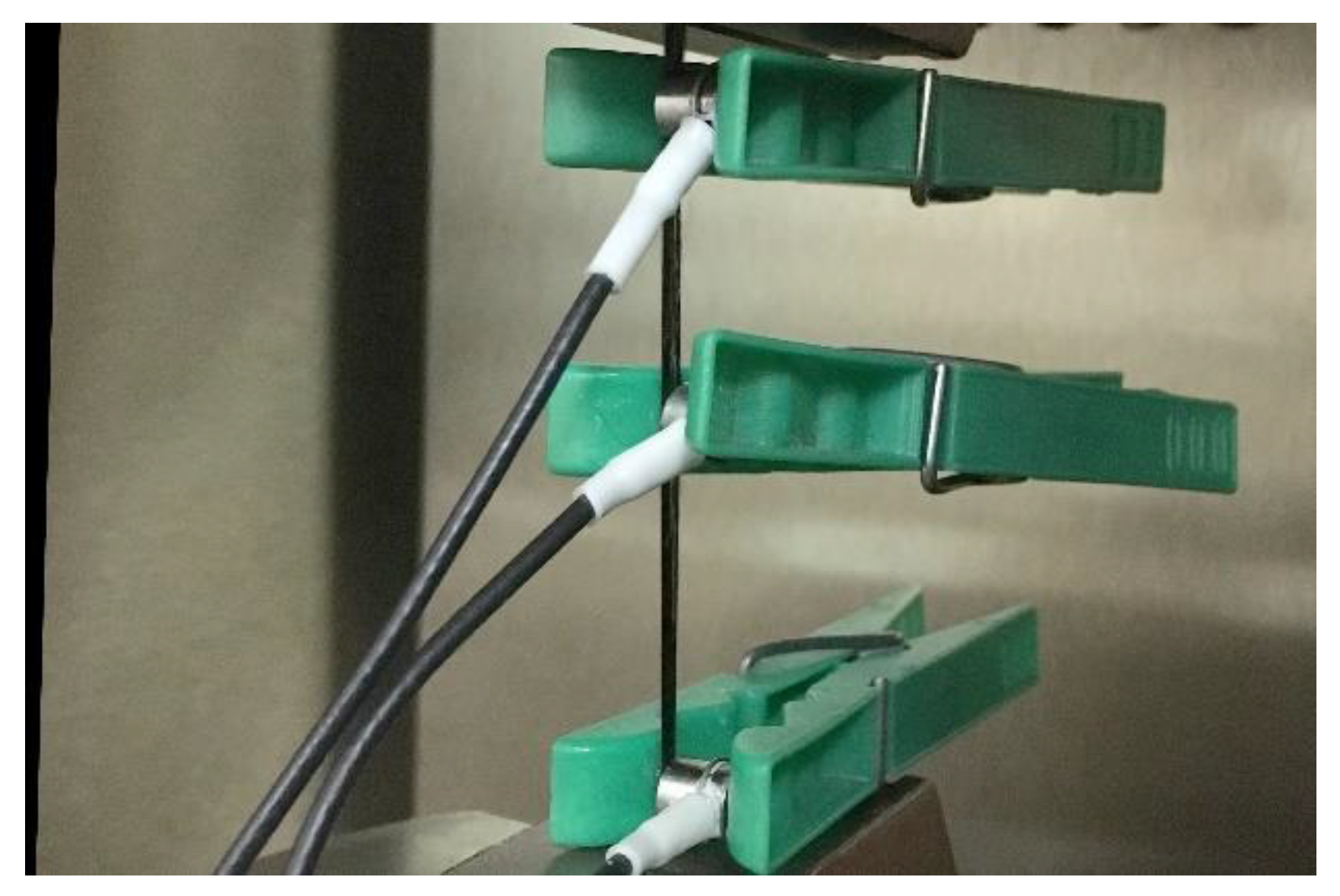
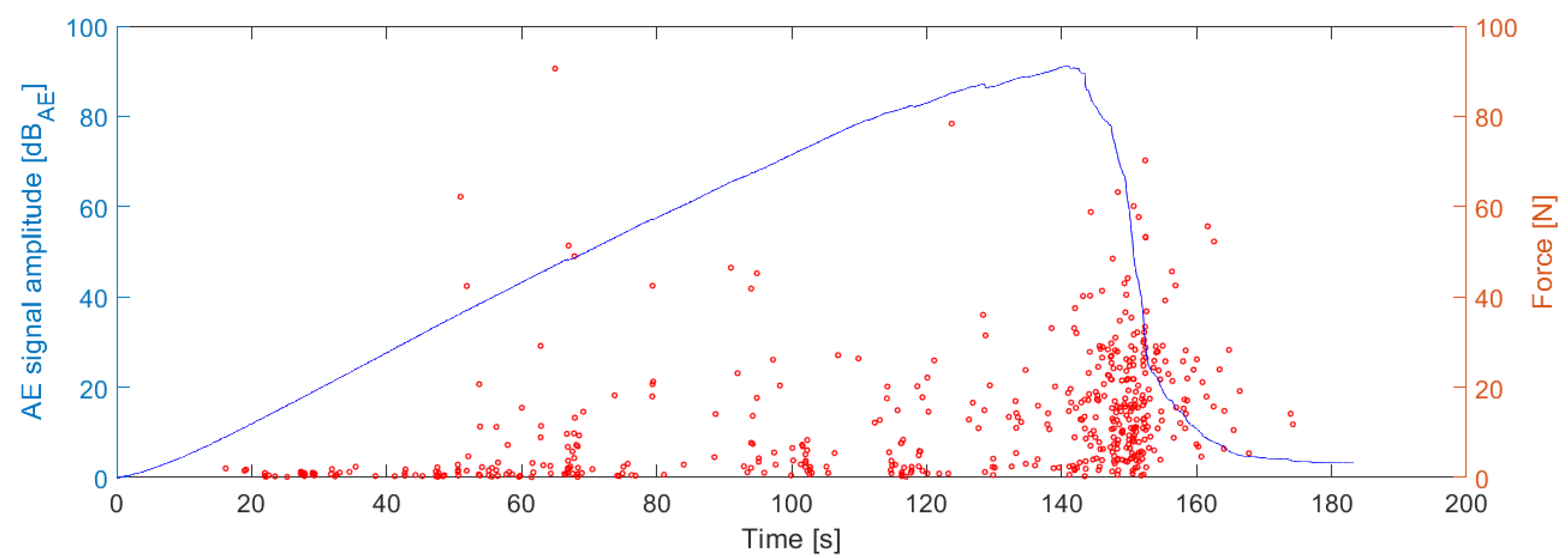

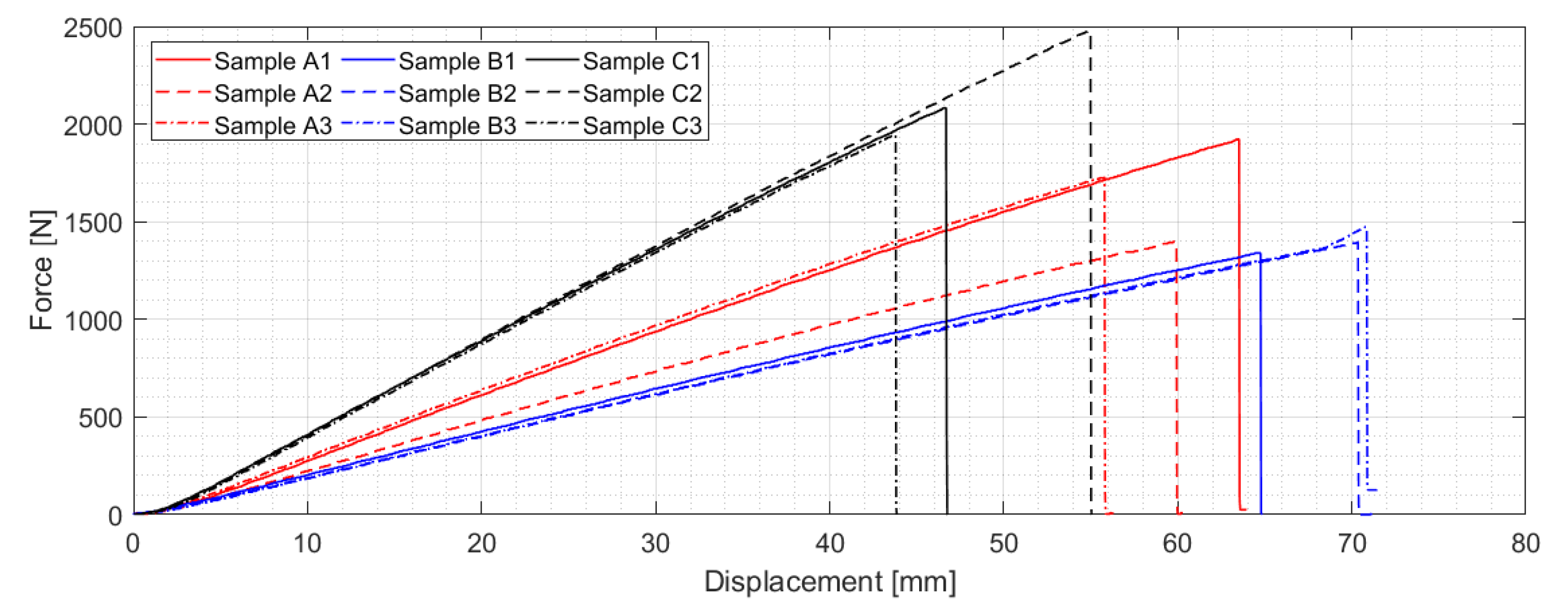

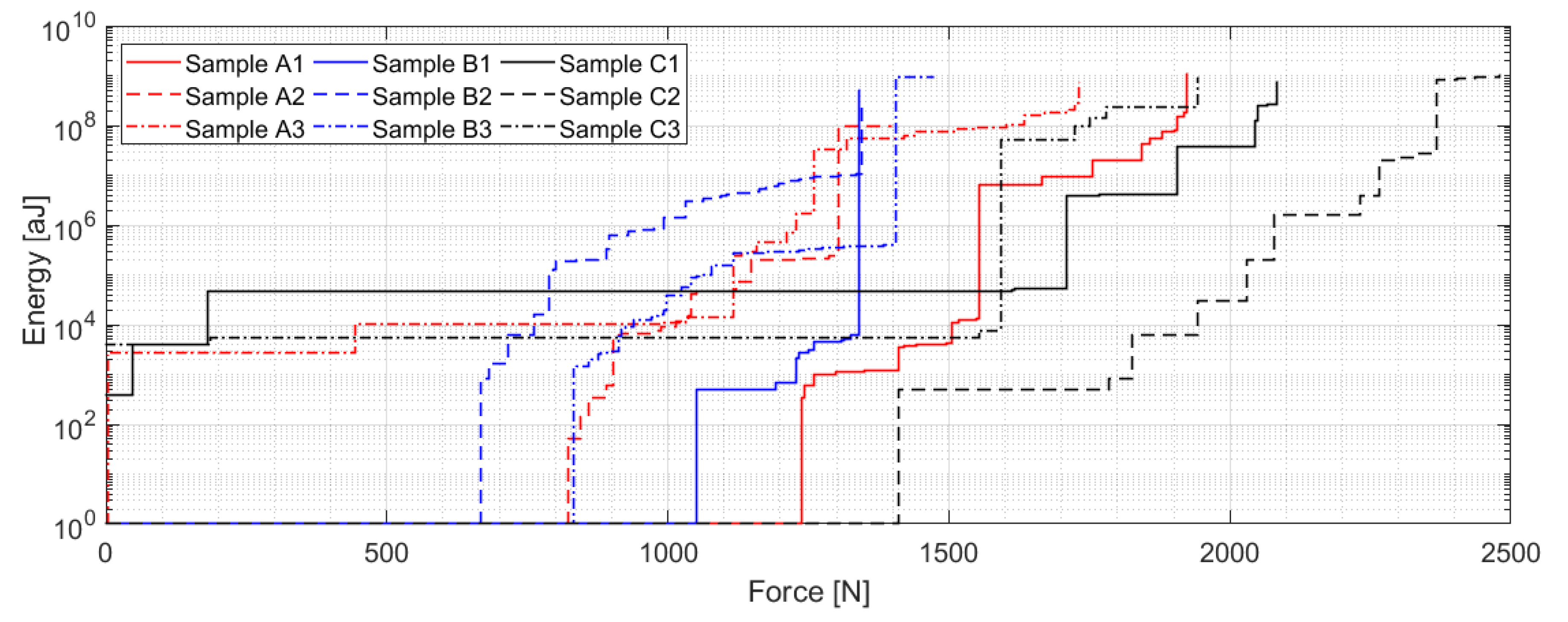

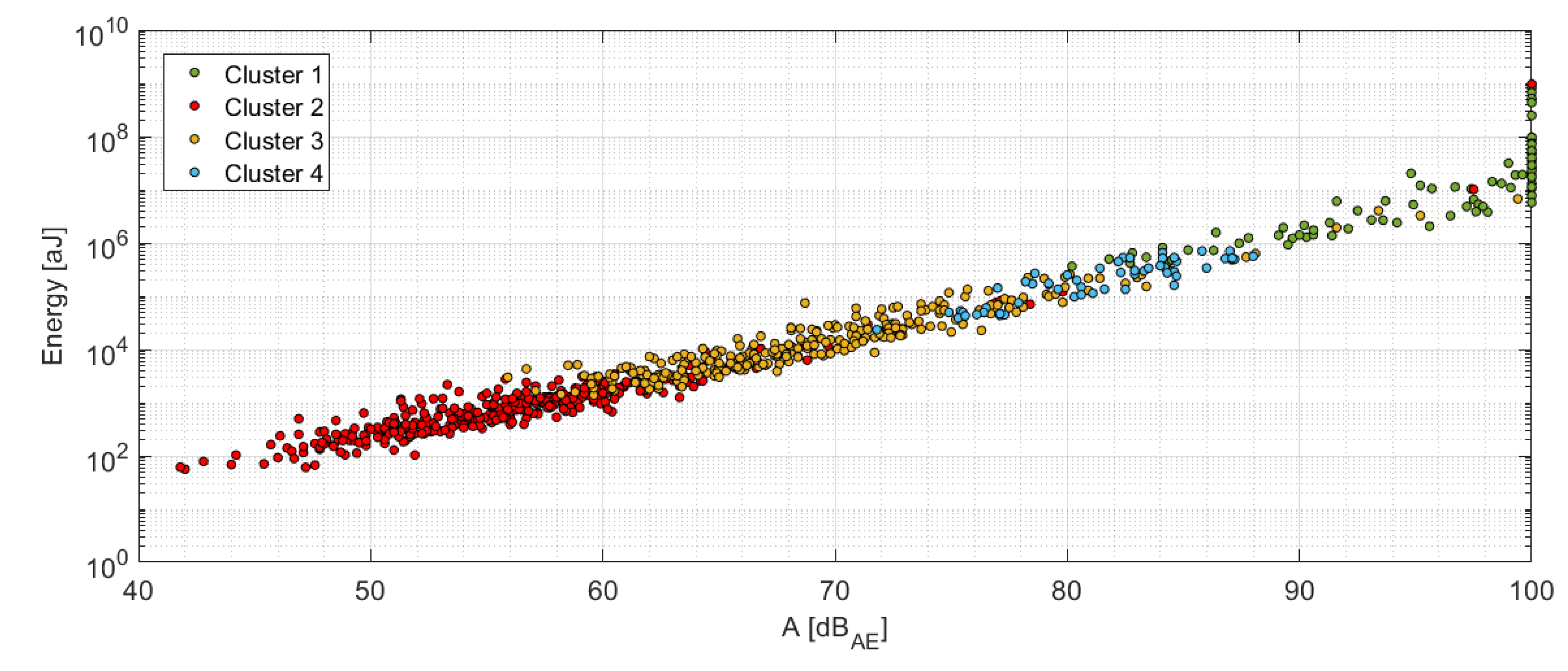
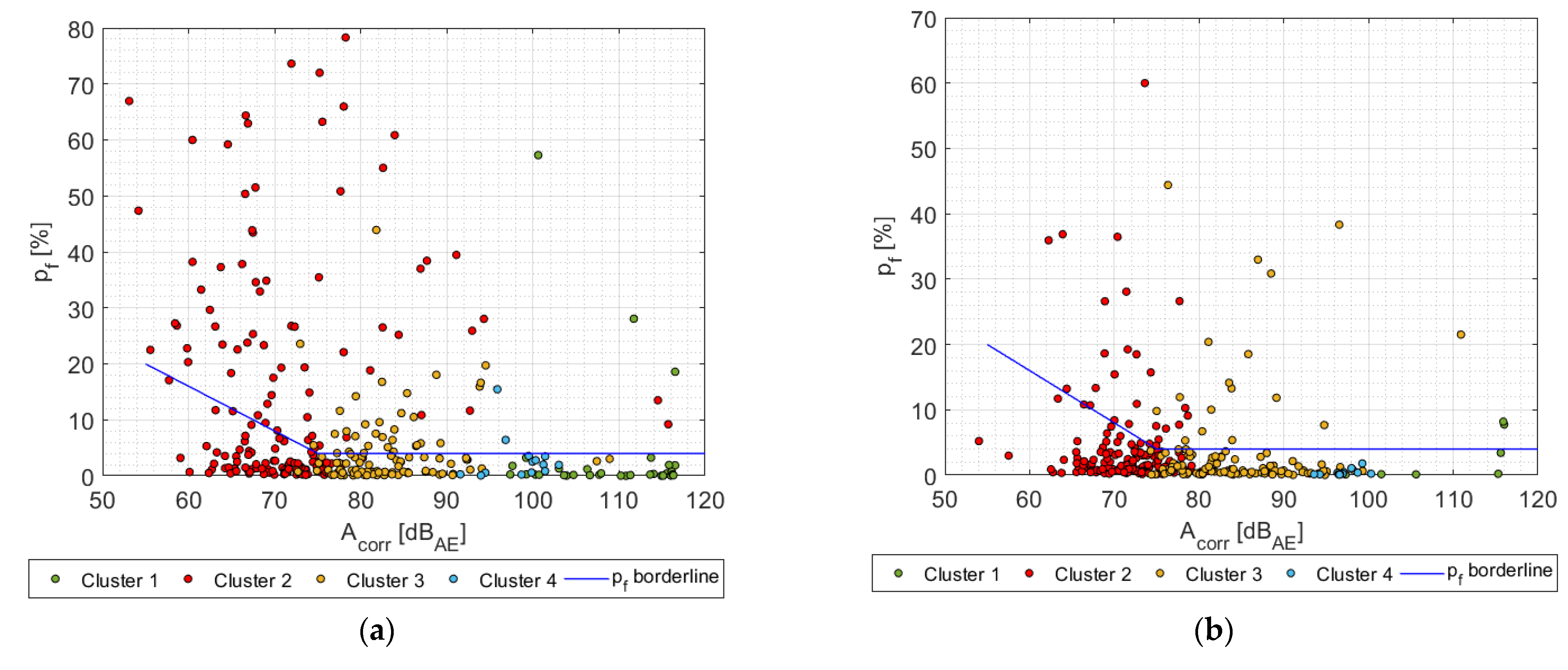
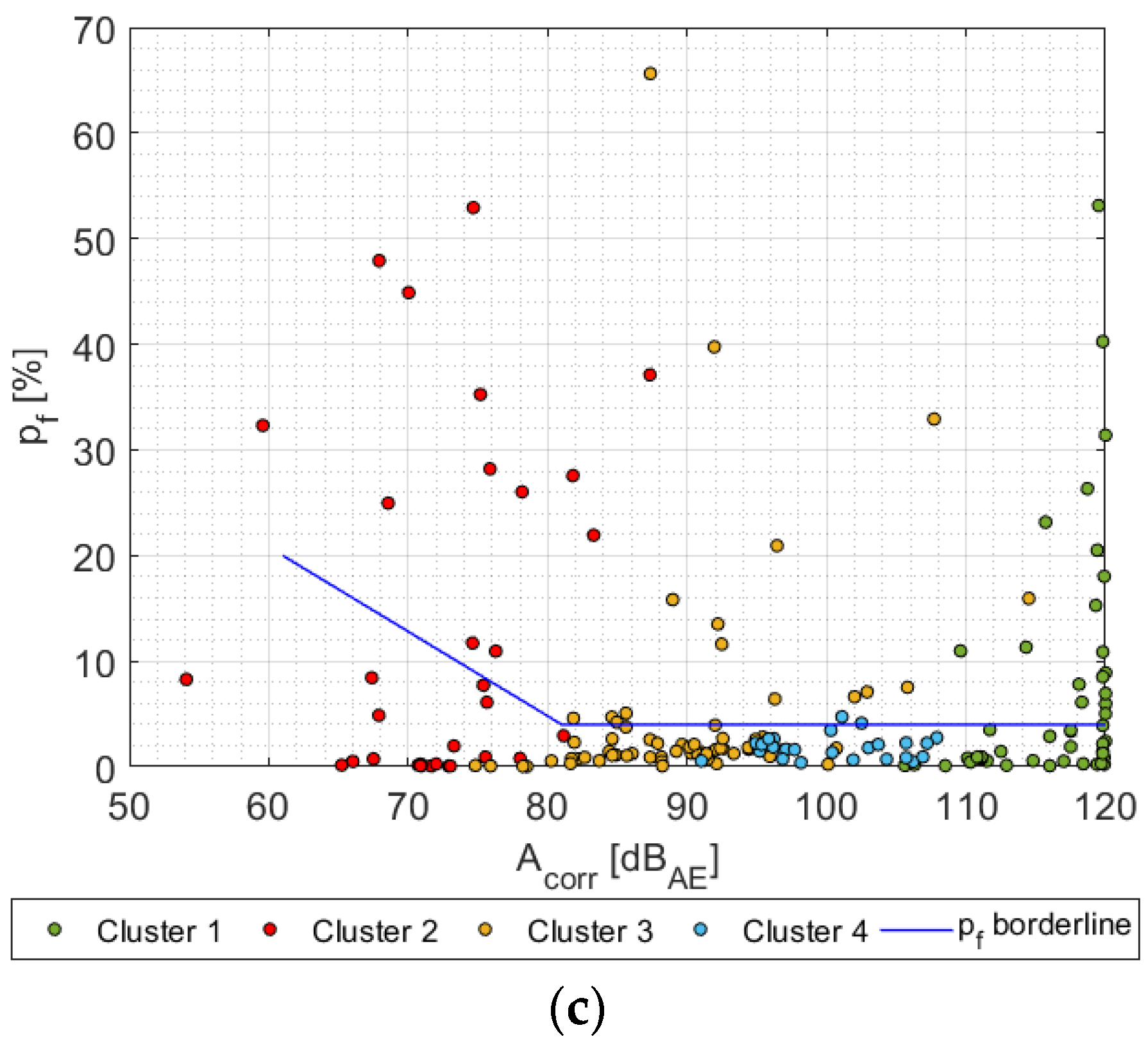
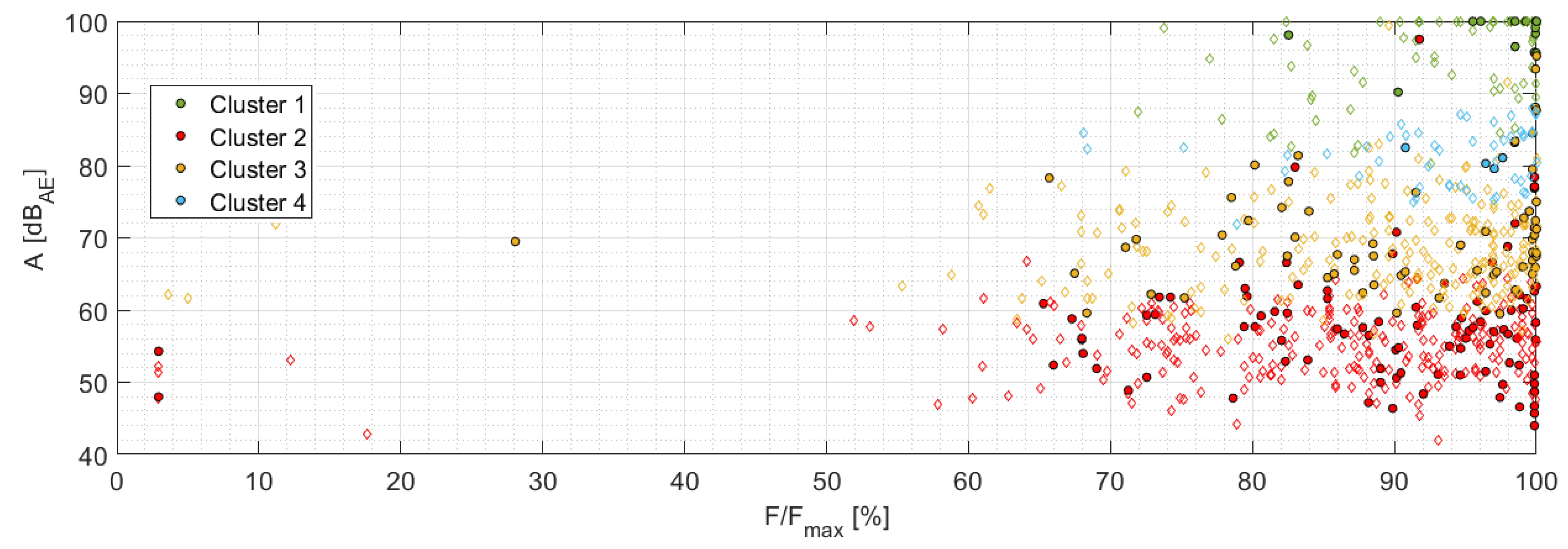
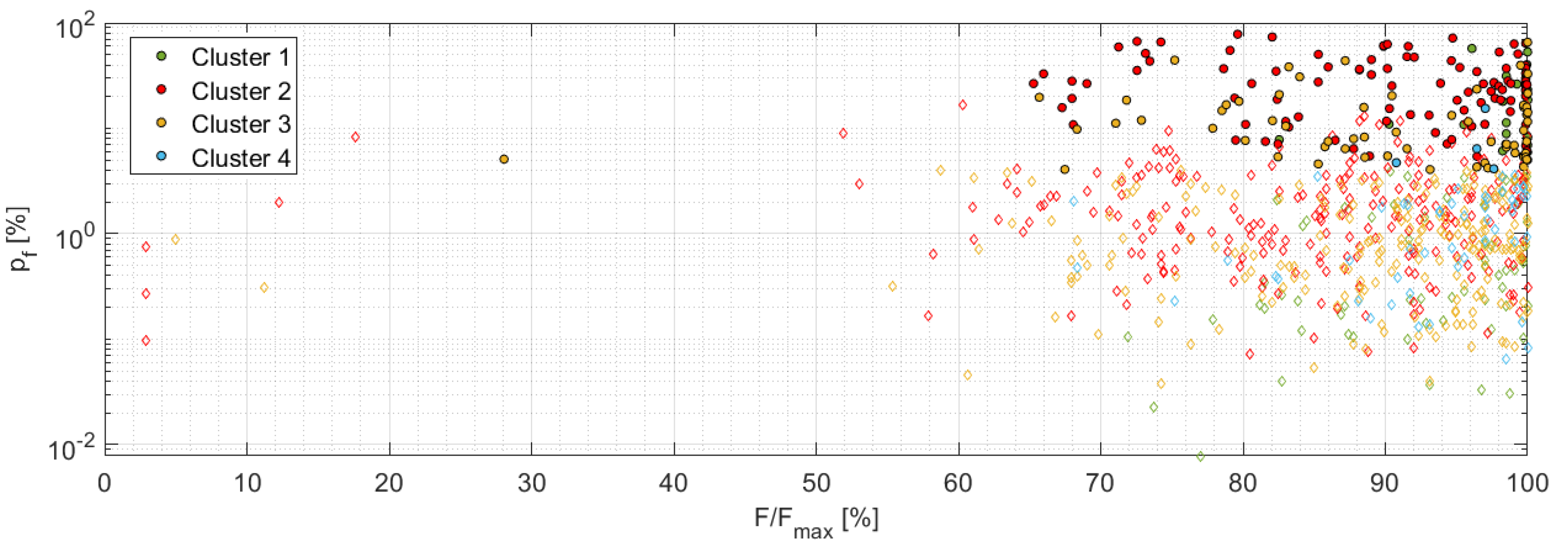


| Damage Mechanism | Characterization |
|---|---|
| Fiber break | Disintegration of single and/or multiple carbon fibers |
| Delamination | Separation of two adjacent plies (Interface failure) |
| Debonding | Integrity failure between fiber and matrix (Interface failure) |
| Matrix cracking | Nucleation and further propagating of (micro)cracks in the matrix |
| Damage Mechanism | AE Signal Characteristics * |
|---|---|
| Fiber break | A: 50–100 dBAE, D: 100–10,000 µs, f = 300–700 kHz |
| Matrix micro cracks | A: 30–40 dBAE, D: <1000 µs, f = 100–250 kHz |
| Matrix micro cracks (propagation) | A: 40–80 dBAE, D: 1000–10,000 µs, f = 100–250 kHz |
| Delamination | A: >70 dBAE, D: 1000–10,000 µs, f = 250–300 kHz |
| Debonding | A: <60 dBAE, f ≅ 300 kHz |
| Property | A Series | B Series | C Series |
|---|---|---|---|
| Wall th. (mm)/Diameter (mm) | 1.45/32 | 0.9/32 | 1.42/32 |
| Fabrication | 4 layers of 200 g/m2 unidir. carbon fabric1 layer of 175 g/m2 aramid/carbon fabric (0°–90°) | 2 layers of 300 g/m2 unidir. carbon fabric1 layer of 280 g/m2 carbon fabric (0°–90°) | 4 layers of 300 g/m2 unidir. carbon fabric |
| Sample Series | Near Field Attenuation (dB/m) | Far field Attenuation (dB/m) |
|---|---|---|
| A | 90 | 33.3 |
| B | 66.6 | 33.2 |
| C | 222.2 | 36.2 |
| Cluster No. | Frequency Range (kHz) | Amplitude Range (dBAE) | Energy Range (aJ) |
|---|---|---|---|
| 1 | 50–150 (>300, minor cases) | >90 | >106 |
| 2 | 50–450 | <65 | 102–104 |
| 3 | 50–300 | 60–80 | 103–105 |
| 4 | 50–200 | 75–90 | 104–106 |
Publisher’s Note: MDPI stays neutral with regard to jurisdictional claims in published maps and institutional affiliations. |
© 2021 by the authors. Licensee MDPI, Basel, Switzerland. This article is an open access article distributed under the terms and conditions of the Creative Commons Attribution (CC BY) license (http://creativecommons.org/licenses/by/4.0/).
Share and Cite
Šofer, M.; Cienciala, J.; Fusek, M.; Pavlíček, P.; Moravec, R. Damage Analysis of Composite CFRP Tubes Using Acoustic Emission Monitoring and Pattern Recognition Approach. Materials 2021, 14, 786. https://doi.org/10.3390/ma14040786
Šofer M, Cienciala J, Fusek M, Pavlíček P, Moravec R. Damage Analysis of Composite CFRP Tubes Using Acoustic Emission Monitoring and Pattern Recognition Approach. Materials. 2021; 14(4):786. https://doi.org/10.3390/ma14040786
Chicago/Turabian StyleŠofer, Michal, Jakub Cienciala, Martin Fusek, Pavel Pavlíček, and Richard Moravec. 2021. "Damage Analysis of Composite CFRP Tubes Using Acoustic Emission Monitoring and Pattern Recognition Approach" Materials 14, no. 4: 786. https://doi.org/10.3390/ma14040786
APA StyleŠofer, M., Cienciala, J., Fusek, M., Pavlíček, P., & Moravec, R. (2021). Damage Analysis of Composite CFRP Tubes Using Acoustic Emission Monitoring and Pattern Recognition Approach. Materials, 14(4), 786. https://doi.org/10.3390/ma14040786






